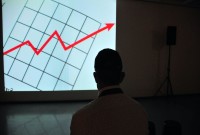- Home
- Business Processes
- Industry Knowledge
- Aerospace Industry
- Automotive Industry
- Banking Domain
- BFSI Industry
- Consumer/ FMCG Industry
- Chemicals Industry
- Engineering & Construction
- Energy Industry
- Education Domain
- Finance Domain
- Hospitality Domain
- Healthcare Industry
- Insurance Domain
- Retail Industry
- Travel and Tourism Domain
- Telecom Industry
- Leadership Skills
- eLearning
- Home
- Leadership
- Career Management
- Bureaucratic Management
Bureaucratic Management
Max Weber gave the theory of Bureaucratic Management in 1915. Bureaucracy is a specific form of organization defined by complexity, division of labor, professional management, and hierarchical management control. Weber's theory has two essential elements - organizational hierarchy and rules-based management. Weber made a distinction between authority and power and advocated that authority must be given to the most competent and qualified people.
Bureaucratic management as one of the schools of classical management emphasizes the need for organizations to function based on professional management and hierarchical management control.
Weber (1864-1920), was a contemporary of Fayol and was one of the major contributors to the management school of thought. He observed that nepotism, which is the hiring of relatives in the organization, based on their relationships with owners and regardless of their professional competence, capabilities, and qualities was prevalent in most organizations. Weber (1915) felt that nepotism was not the right way of running an organization, was grossly unjust, and eventually hindered both the progress of individuals as well as growth or organizations. He, therefore, identified the characteristics of an ideal bureaucracy. According to Weber, bureaucracy represents the most efficient organizational design. Taylor emphasized the separation of planning and doing tasks.
Bureaucracy word is derived from the German word 'bur' and means “office”, referred to organizations that operated on a rational basis. According to Weber, "bureaucracy is a highly structured, formalized, and impersonal organization. In other words, it is a formal organization structure with a set of rules and regulations". Many leaders follow the bureaucratic leadership style.
Advantages of Bureaucracy
Nowadays, the term "bureaucracy" is used to denote excessively complicated administrative procedures with multilayered systems and processes. Clubbed with rigidness in operations with mountains of paperwork, procedures, and rules bureaucratic model is believed to slow down an organization's capacity to achieve stated goals. However, the bureaucratic characteristics of organizations outlined by Weber have certain advantages.
- It helps remove ambiguities and inefficiencies that characterize many organizations.
- Undermine the culture of patronage that he saw in many organizations.
- Competence and creativity thrive within a bureaucracy as bureaucracy demands a higher level of education and self-direction.
- The structure of bureaucracy creates more job security and provides a better work-life balance to the employees.
- In a bureaucracy impersonal relationships are formed, equality is respected and provides everyone an equal opportunity to succeed.
- In a bureaucracy, specific roles and duties are assigned that enable managers to supervise work and facilitates a team-based environment.
- It encourages specialization and promotes problem-solving and cost efficiencies by putting the best people at the best jobs.
Sources of Power
Weber also made a distinction between authority and power. Weber believed that power educes obedience through force or the threat of force which induces individuals to adhere to regulations. According to Max Weber, there are three types of power in an organization:-
- Traditional Power
- Charismatic Power
- Bureaucratic Power or Legal Power
Features of Bureaucracy:
- Division of Labor.
- Formal Hierarchical Structure.
- Selection based on Technical Expertise.
- Management by Rules.
- Written Documents.
- Only Legal Power is Important.
- Formal and Impersonal relations.
Suggested Reading and Resources
Related Links
You May Also Like
-
Quantitative Theory of Management
The quantitative management approach is given by the mathematical school that recommends the use of computers and mathematical techniques to solve complex management issues and assist in the managerial decision-making process. Managers observe historical quantitative relationships and use quantitative techniques such as statistics, information models, and computer simulations to improve their decision making.
-
Emergent leadership occurs when a group member is not appointed or elected as leader, but rather that person steps up as the leader over time within-group interactions. Have you ever faced challenges in getting accepted into your new role of position as a leader? Groups don't automatically accept a new "boss" as a leader. Emergent leadership is what you must do when taking over a new group. Learn more about emergent leadership.
-
In its simplest sense, decision-making is the act of choosing between two or more courses of action. Decision making is a key skill in the workplace and is particularly important if you want to be an effective leader. When decisions have to be made, there are several stages that you should go through to reach a practical solution. Understand the meaning and importance of decision making and how to look at it as a process.
-
Productivity is defined not in terms of the number of goods produced, but in terms of value-added per employee. Customers don’t really buy goods and services but in fact, they buy a value - something they value. The future is all about tangible products fulfilling intangible needs. Ideas like this can transform a business and provide them a competitive advantage to thrive in the future.
-
Investment Theory of Creativity
Sternberg in the year 2006, proposed the investment and confluence theory focused on understanding creativity. According to the investment theory, creativity requires a confluence of six distinct but interrelated resources known as intellectual abilities, knowledge, styles of thinking, personality, motivation, and environment. It emphasizes that creativity is not about one thing, but about a system of things.
-
Process & Stages of Creativity
Creative ideas do not come just like that. There is a process to it. There are a number of techniques of creativity to support the generation of ideas but the widely practiced ones are brainstorming and lateral thinking. Most innovations are not so much the product of sudden insights as they are the result of a conscious process that often goes through multiple stages. The creative process can be divided into four stages of preparation, incubation, evaluation, and implementation.
-
Modern Approaches to Management
The modern approaches to management look at organizational management in the current context. They take a holistic approach and look at organizations as a collection of interrelated parts influenced by both internal dynamics and also the larger external environment. These modern management theories have played a significant role in the evolution of management studies.
-
In today's business world, proficiency in management skills is essential for career growth and success. Managerial skills can be defined as attributes or abilities that are essential for every leader and manager to succeed and fulfill specific tasks expected from them by the organization.
-
Frederick Winslow Taylor started the “Scientific Management Movement”, and attempted to study the work process scientifically. Scientific management, also called Taylorism, was a theory of management that analyzed and synthesized workflows. It is a system for increasing the efficiency of manpower to its maximum potential and streamlining production to improve efficiency. This article explores this theory in more detail.
-
Thinking & Problem Solving Skills
Today's dynamic business world demands that you make decisions that significantly boost productivity and drive competitive advantage. But how do you know whether a decision will benefit the organization? And how do you know that the decisions are based on rational and statistical reasoning? Explore how to become a dynamic problem solver with the skills to make accurate decisions.
Explore Our Free Training Articles or
Sign Up to Start With Our eLearning Courses

About Us
Learning
© 2023 TechnoFunc, All Rights Reserved










